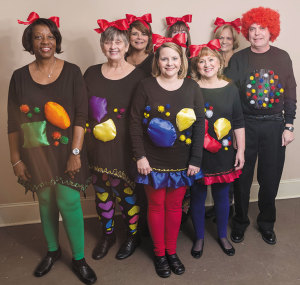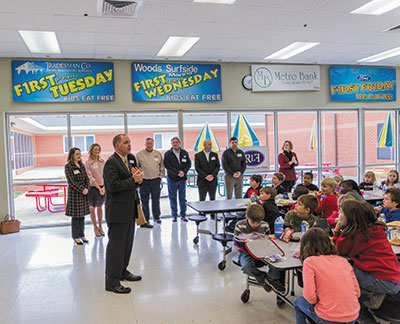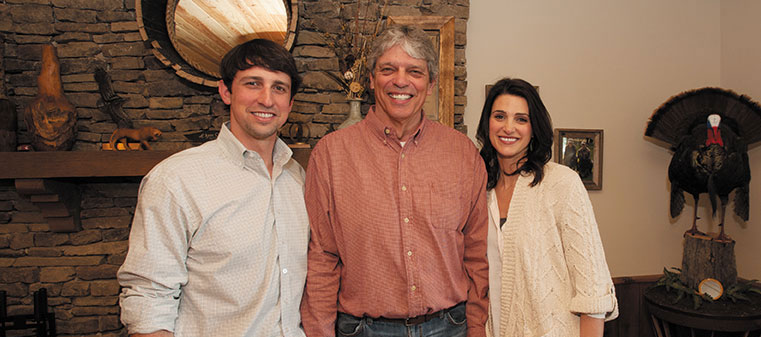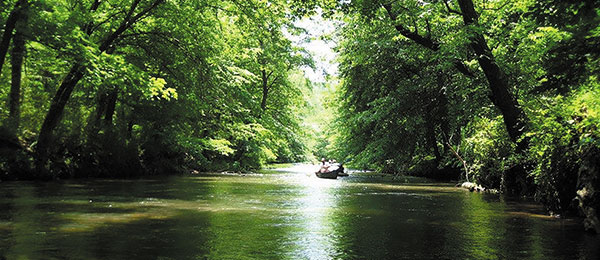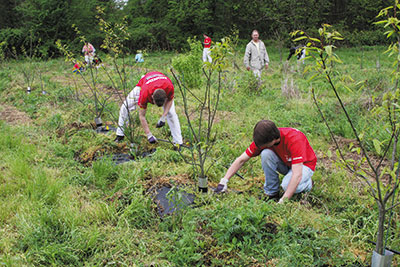 Croyle children inherit
Croyle children inherit
legacy of love
Story by Leigh Pritchett
Photos by Wallace Bromberg Jr.
The house buzzed with the afternoon’s activities of five school-age girls.
Karen was learning to tune her guitar, and Rosa giggled as photos were snapped of her. Emmalee showed off her newly organized closet. Lorenza discussed her plans to build a Hobbit hole in Tennessee and work for Lifeway Christian Resources. With a big, thick book to read, Gail curled up in a comfy chair. Although time was drawing near for the group to leave for church, Tony and Rhona Osborne remained unruffled. They gently urged the girls toward the goal of getting to the Wednesday-night service on time.
The Osbornes have much experience in raising children. They have, after all, parented more than 52 children in the last 25 years.
“My wife and I feel like this is what we’re called to do — be parents,” said Tony. They have been houseparents with Big Oak Ranch for 25 years and have the same passion for it as when they first started.
The reason is “them,” Rhona said, pointing to the five young ladies growing up happy and healthy. Rhona has seen healing taking place in the girls’ lives, and it touches the mother’s heart within her.
“They, way too often, minister to me,” Rhona said.
The Osbornes are just one of the houseparent couples at Big Oak Girls’ Ranch near Springville. Theirs is one of eight homes at the ranch, situated on 325 acres of rolling hills, woodlands and pasturelands along U.S. 11.
Another house will be completed this summer, said Brodie Croyle, associate executive director of Big Oak Ranch that 64 children call home.
“We are never full,” said Reagan Phillips, Brodie’s sister and director of Big Oak Ranch’s childcare team. Big Oak will always make room for more children — always.
The Osbornes’ longevity is not unusual for Big Oak Ranch. Brodie said the Osbornes’ commitment is the kind of calling for which the administration looks when selecting houseparent couples.
Houseparents are the frontline warriors of the ranch, he said. They are with the children each and every day. These “moms” and “dads” exemplify what God intended for a husband and wife to be and the children see this consistently.
The houseparents show what “family” truly means and lovingly incorporate others into it, said Brodie and his dad, John Croyle, who is founder and executive director of Big Oak Ranch.
The family units live, work, play and worship together. They laugh together. They cry together.
The houseparents model the four promises on which Big Oak has functioned since its inception:
“I love you.”
“I’ll never lie to you.”
“I’ll stick with you until you’re grown.”
“There are boundaries; don’t cross them.”
Being in an environment where these promises are kept on a daily basis creates a sense of love, security and permanence for any child, but especially for a young person from a background of abuse, neglect or abandonment.
As further demonstration to the youths that the commitment is real and long term, Big Oak seeks custody whenever possible. This lets the children know that no one is going to send them away or walk out on them, explained John.
“They’re not bad kids,” he said. “They come from bad circumstances.”
When a need emerges, fill it
Years ago, John met a blonde-haired, green-eyed girl at a Department of Human Resources office.
Her name was Shelley, and she was 12 years old.
She was dirty and thin.
Her father had physically and sexually abused her while her mother held her down. Shelley had to undergo surgery to repair damage from the abuse.
John begged a judge to allow him and his wife, “Tee,” to adopt Shelley. The judge denied the request because Shelley would have had to live at Big Oak Boys’ Ranch, which was the only ranch in the Big Oak ministry at that time.
John told the judge that Shelley would surely be dead in six months if she were returned to her parents.
“I was wrong,” John told Discover Magazine. “It was three (months.)”
Shelley’s life story weighed on John’s heart. Then, in 1988, he was able to establish a ranch for girls needing a family and a home. It is dedicated in memory of Shelley.
Like its counterpart for boys, the girls’ ranch has multilevel homes in a secure community setting that includes a lake, pool and gym, as well as a barn for horses. Each ranch also has a “transition” home, where residents who are attending college or have entered the workforce learn to become independent.
In addition, the girls’ ranch is where Big Oak’s administrative offices are located.
The girls’ ranch is the second of three ministries for Big Oak Ranch and has been home to more than 600 girls thus far. The other two facets of Big Oak Ranch are in Etowah County – Big Oak Boys’ Ranch near Southside and Westbrook Christian School in Rainbow City.
All three grew from the calling John felt on his life as a 19-year-old.
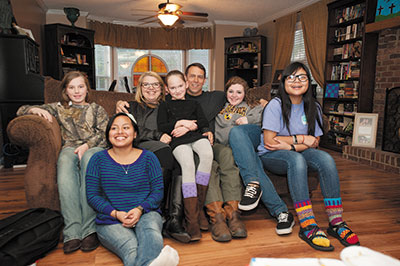 That summer as a camp counselor, John met a boy whose job was to be “banker” and “timekeeper” for his mother, a prostitute. The boy listened intently to what John taught him and ultimately asked Jesus to come into his heart to be his Savior.
That summer as a camp counselor, John met a boy whose job was to be “banker” and “timekeeper” for his mother, a prostitute. The boy listened intently to what John taught him and ultimately asked Jesus to come into his heart to be his Savior.
Through that experience, John sensed God leading him to open “a Christian home for children needing a chance.”
In college at the University of Alabama, John played defensive end under the coaching of Paul “Bear” Bryant. During John’s time at the Capstone, the football team won three Southeastern Conference championships and the 1973 National Championship. John was named to Second Team All-American.
Then, the NFL came calling.
John’s plan was to play in the NFL to earn the money needed to start a ranch.
When John told Bear Bryant his intention, the coach explained that a man does not “play” for the NFL; he “marries” it. Bryant advised John to forget the NFL and go build the home for children.
Just before the NFL draft was to take place, John was in a hallway where he was to be weighed and measured. It was there that he made his decision and told officials of an NFL team to use their draft pick on someone other than him.
People who believed in John’s mission – Bryant being one of them – gave financial assistance and, in late summer of 1974, Big Oak Boys’ Ranch was established.
Its name comes from the Bible verse Isaiah 61:3: “And they shall be called oaks of righteousness, the planting of the Lord that He may be glorified.”
John and five boys moved into a farmhouse on 120 acres near Southside.
Tee joined the family seven months later when she and John married.
During the 41 years that have followed, “2,000 children have had a chance at life that might not have had a chance,” said Brodie.
“Our first kid’s 58 now,” John added.
The boys’ ranch has since grown to nine homes. Currently, 55 children live there.
Together, the girls’ ranch and the boys’ ranch can accommodate a total of 144 children, plus 24 transitioning residents. The two ranches are supported exclusively through private donations. According to Big Oak information, about $12,000 is required to provide support for one child for one year.
In 1990, the ranch system added its third ministry – a school. For the price of $1, Big Oak purchased Westminster Christian School, renaming it Westbrook Christian School.
Approximately 700 students from 3-year-old kindergarten through 12th grade go to Westbrook. All Big Oak children attend Westbrook and account for 20 percent of the student body. Other pupils come from Marshall, Jefferson, St. Clair, Cherokee and Etowah counties. More than 500 students pay tuition to attend this private school, John said.
Tee, an educator for more than 30 years, teaches calculus there.
Westbrook has a 98-percent graduation rate, John said. Last year, the senior class garnered $2.2 million in scholarship offers.
As for Big Oak Ranch, “we’ve got 20 in college right now,” John said.
All in the family
When Brodie and Reagan came home from the hospital as newborns, they had 60 big brothers, Brodie said.
And the family progressively got bigger through the years.
“We had the perfect childhood, we think,” Reagan said.
Year after year, she and Brodie watched their parents live out their faith in Jesus and selflessly show love to hundreds of young people.
Reagan and Brodie also witnessed time and again the brokenness that had occurred in the lives of many children.
Brodie tells of a particular scene that happened when he was 5 years old.
A vehicle with a man and three boys inside pulled up at the ranch. The man explained that his girlfriend had given him an ultimatum – it was either her or his children.
The man said he was choosing his girlfriend.
The oldest of the three boys quickly decided that living at Big Oak sounded pretty good to him. The middle child bolted from the vehicle and ran away. It took ranch staff members three hours to find him.
The youngest child – a 6-year-old – clung desperately to the man. The child begged his father not to leave him like the boy’s mother had done.
Years later, Brodie would come to understand that what he saw that day as a kindergartner significantly influenced the mission he would have as an adult.
After high school, both Brodie and Reagan went to the University of Alabama on athletic scholarships. Reagan played basketball until a back injury ended her career. From 2002-2005, Brodie was starting quarterback for the Crimson Tide.
From there, Reagan became a model in Europe and Brodie an NFL player with the Kansas City Chiefs from 2006-2012.
Afterward, Brodie and wife Kelli returned to Tuscaloosa, where Brodie worked in real estate for a time.
Concluding that the “catwalk” was not the life she was called to lead, Reagan went back to Tuscaloosa to earn a master’s degree in counseling.
Brodie and Reagan grew to realize that all their earlier experiences — how they grew up, what they saw happen in the lives of broken children, how their parents cared so deeply – were molding, shaping and preparing them for a purpose.
Their parents’ ardent devotion to protecting and helping children had become Brodie and Reagan’s devotion as well.
As a result, Reagan – wife of John David Phillips and mother of three boys – came back to the ranch. She is now leading the childcare team, which is the ministry arm of the ranch.
Understanding that his heart was at Big Oak, Brodie returned there as well and assumed the leadership role of day-to-day operations of the ranch.
Brodie and Reagan say they are completely committed to carrying on the work their parents began.
“This is not a job to us,” said Brodie, father of two boys. “… We’re going to continue to do what God called our family to do 40 years ago. We will continue to be faithful.”
For more information about Big Oak Ranch, as well as the books John Croyle has authored, visit www.bigoak.org.
 Looking to create ‘Medical Home’
Looking to create ‘Medical Home’














